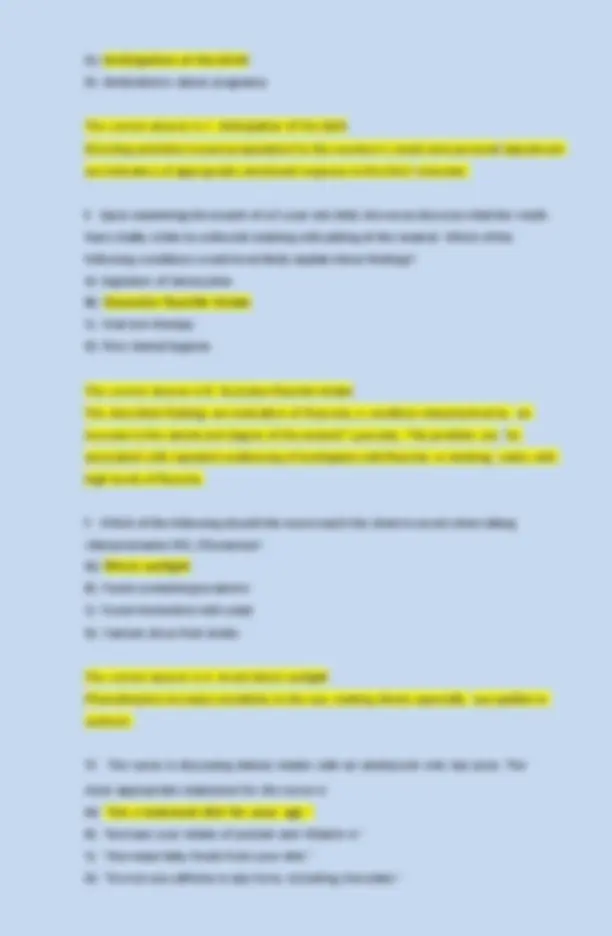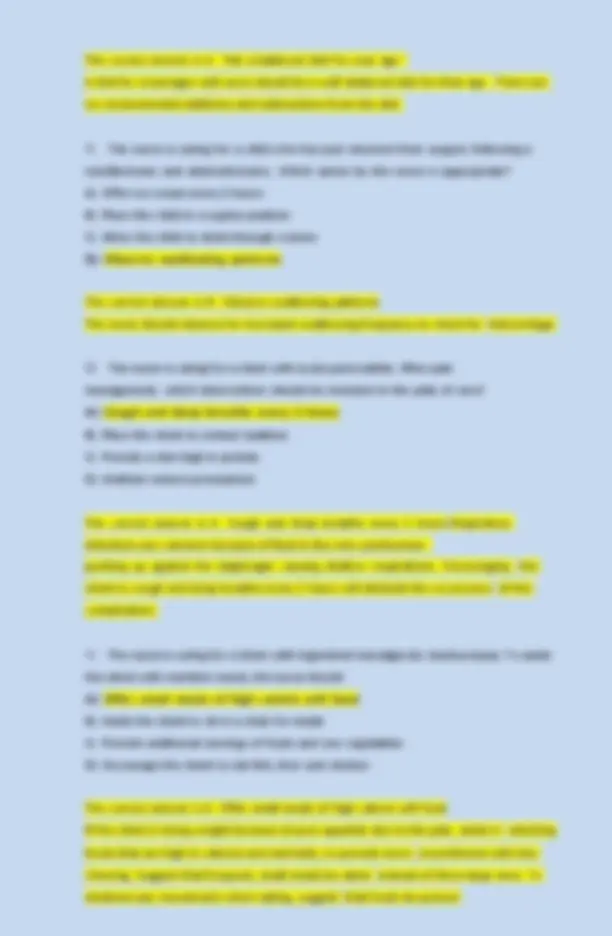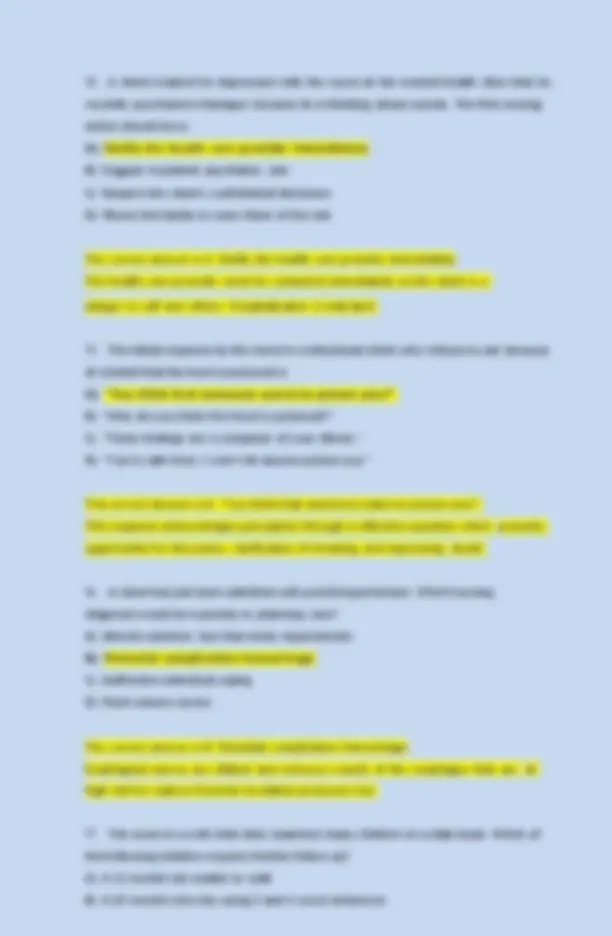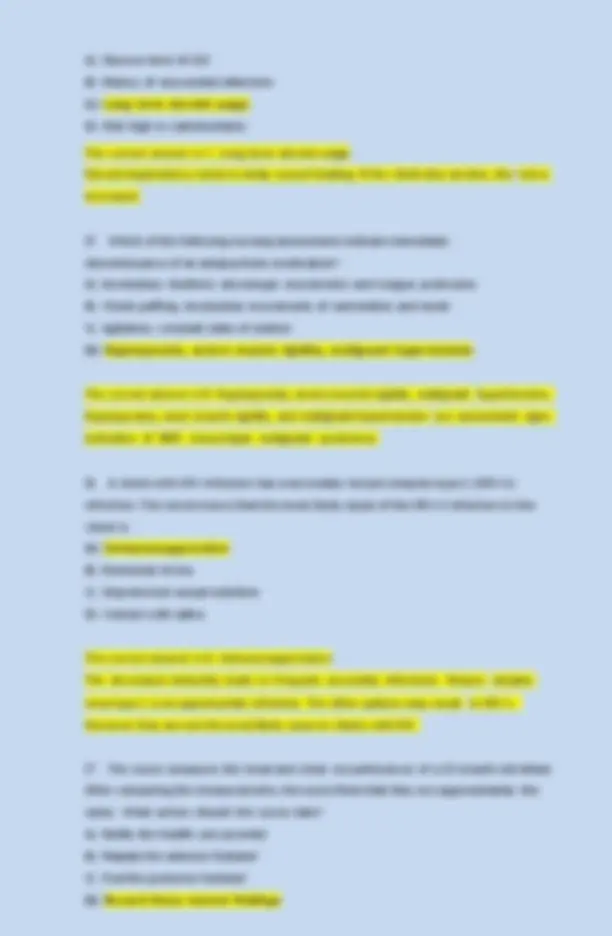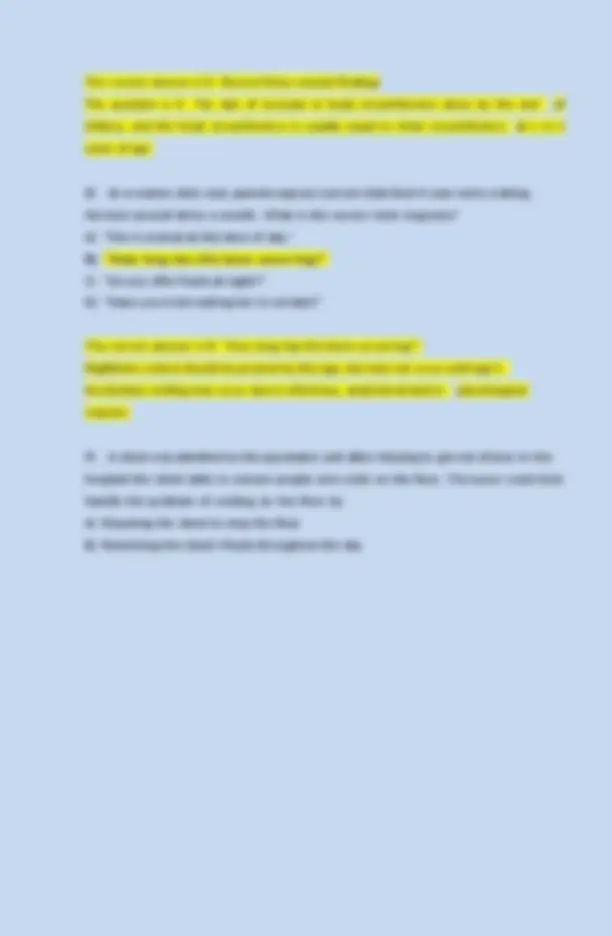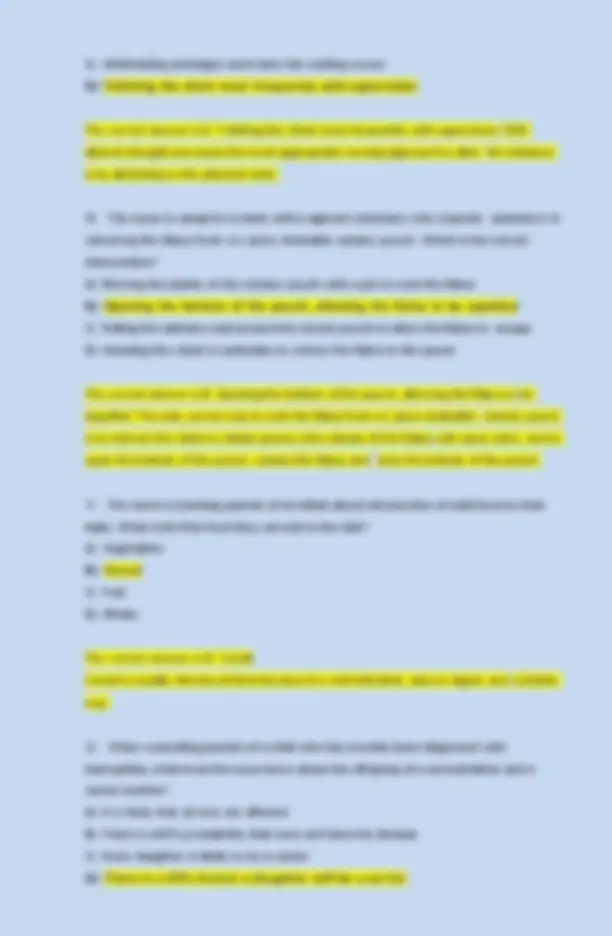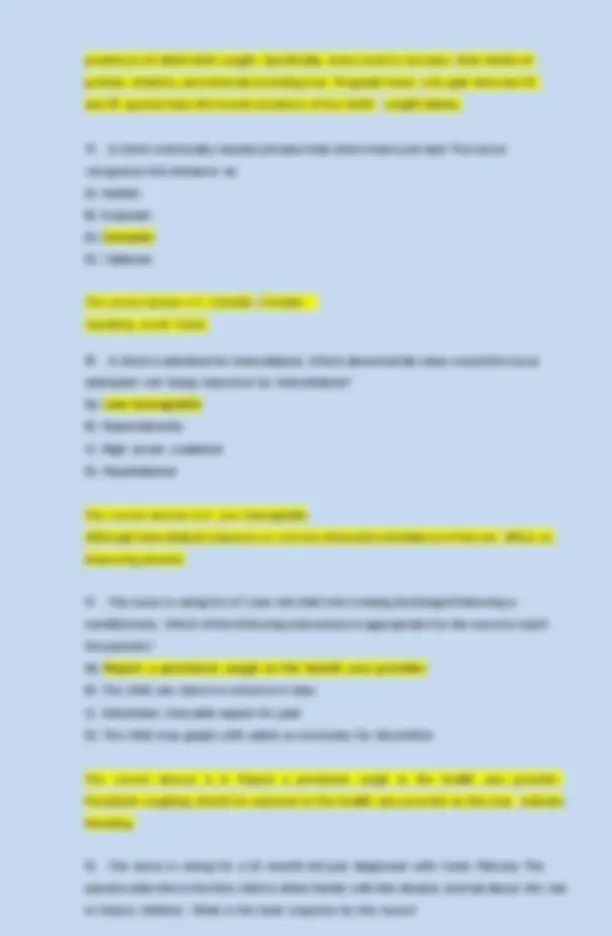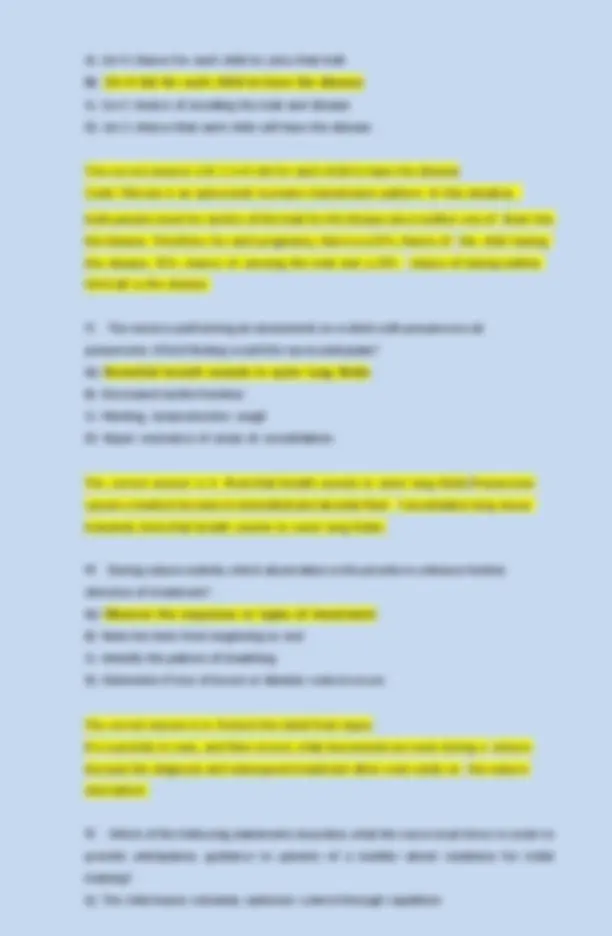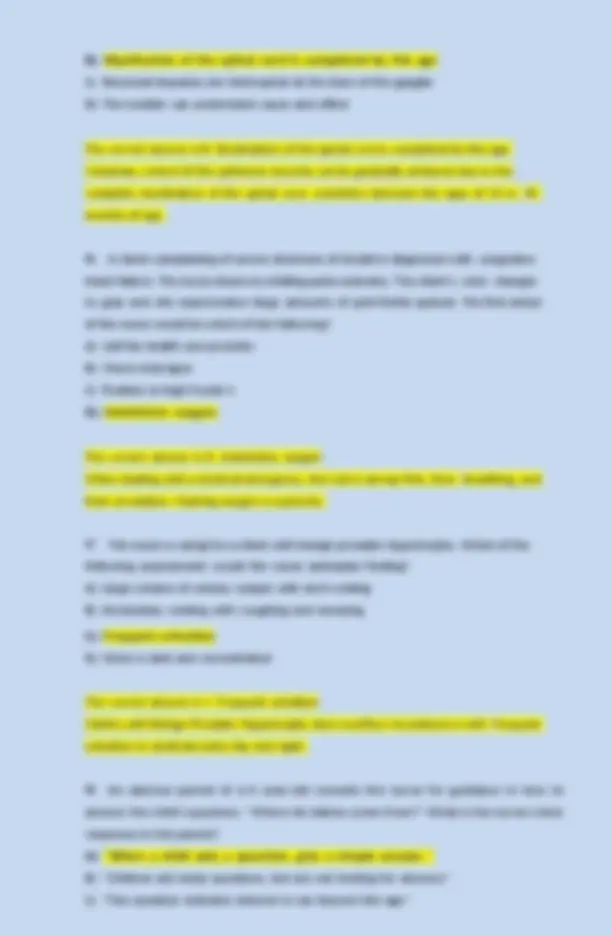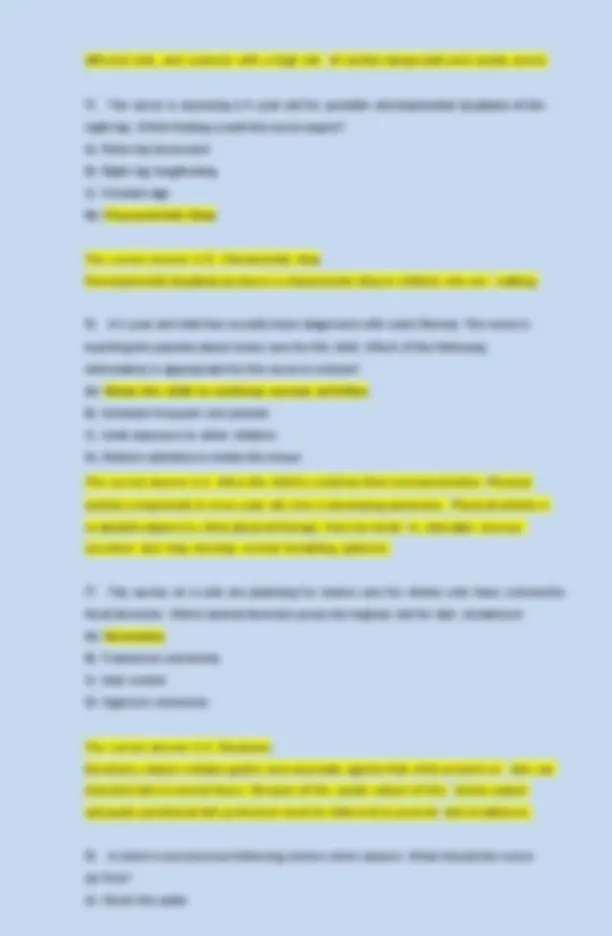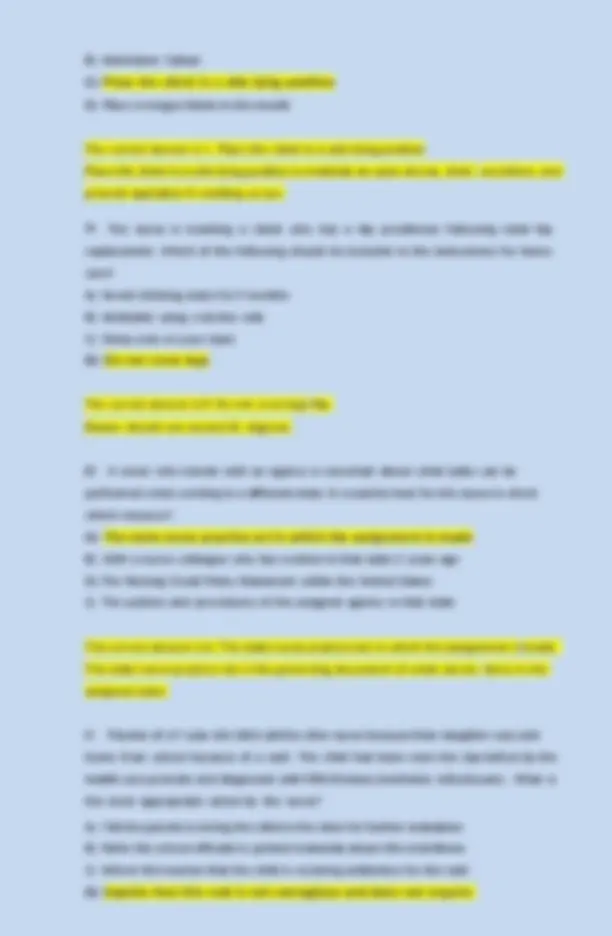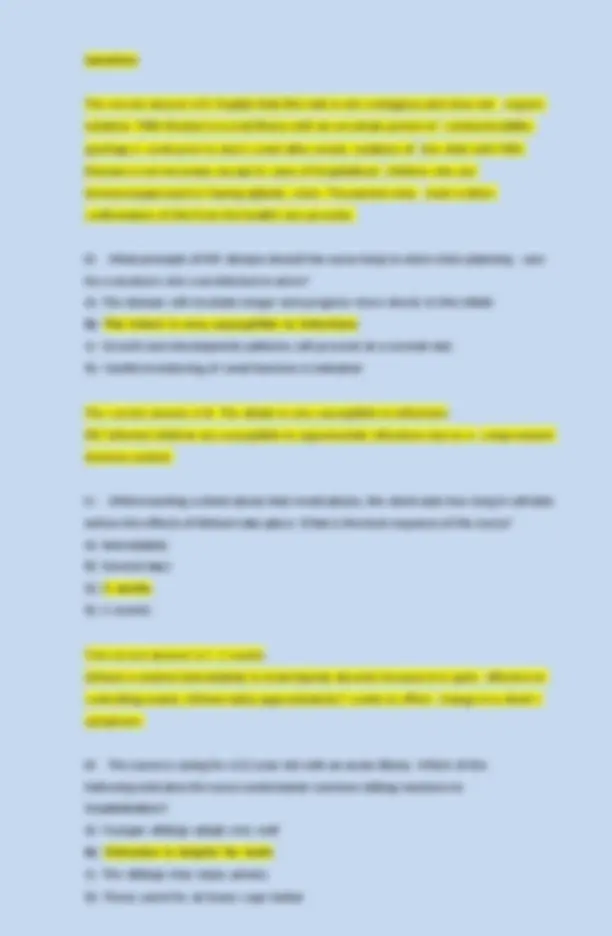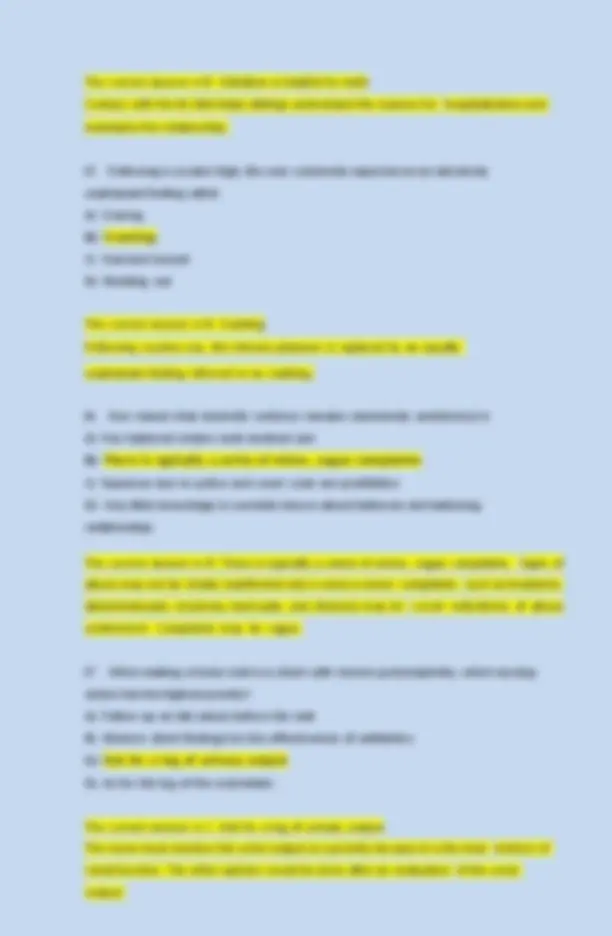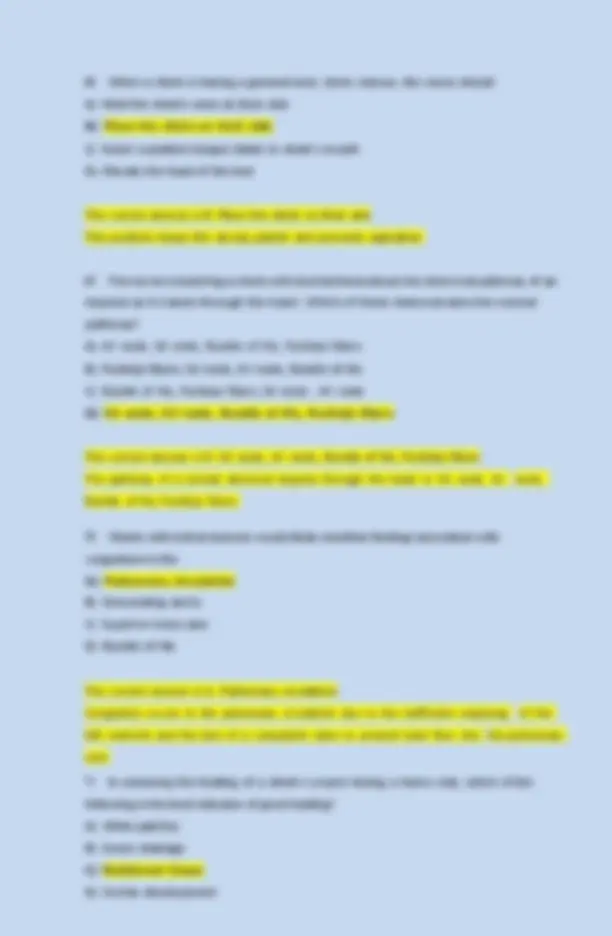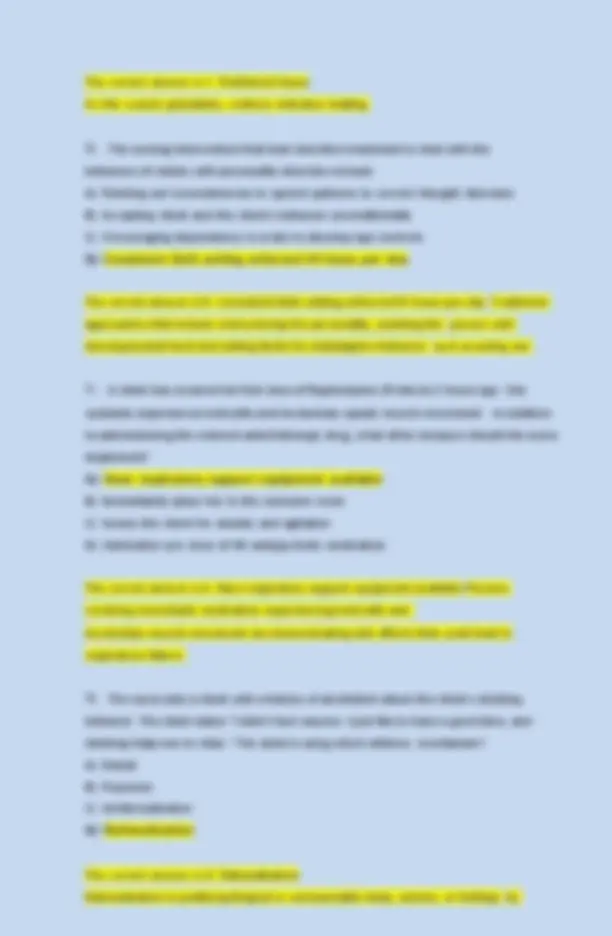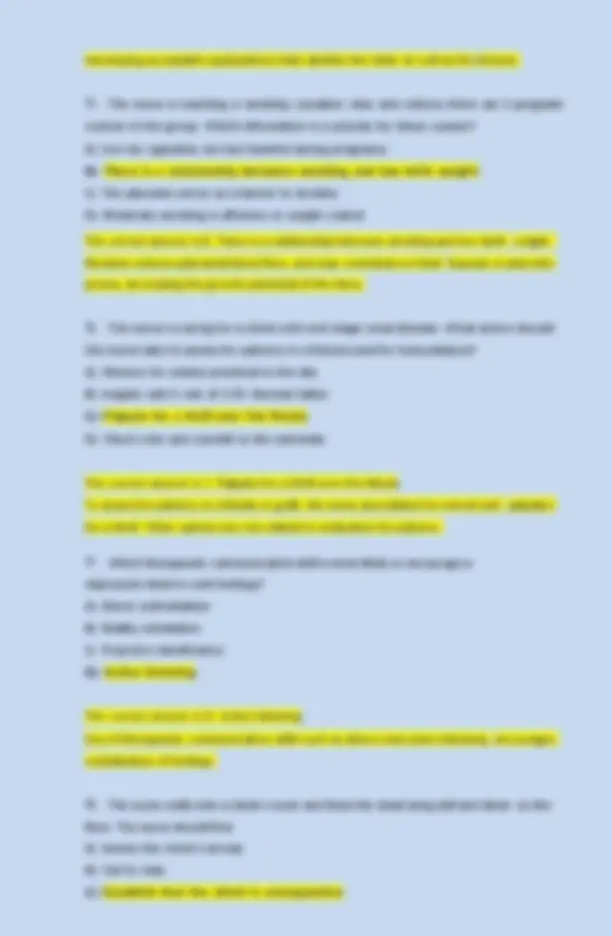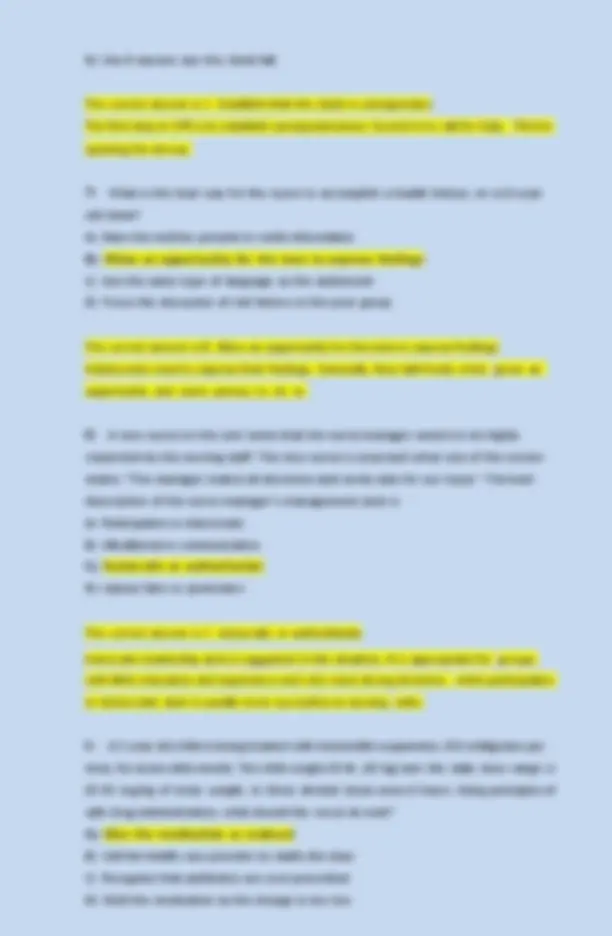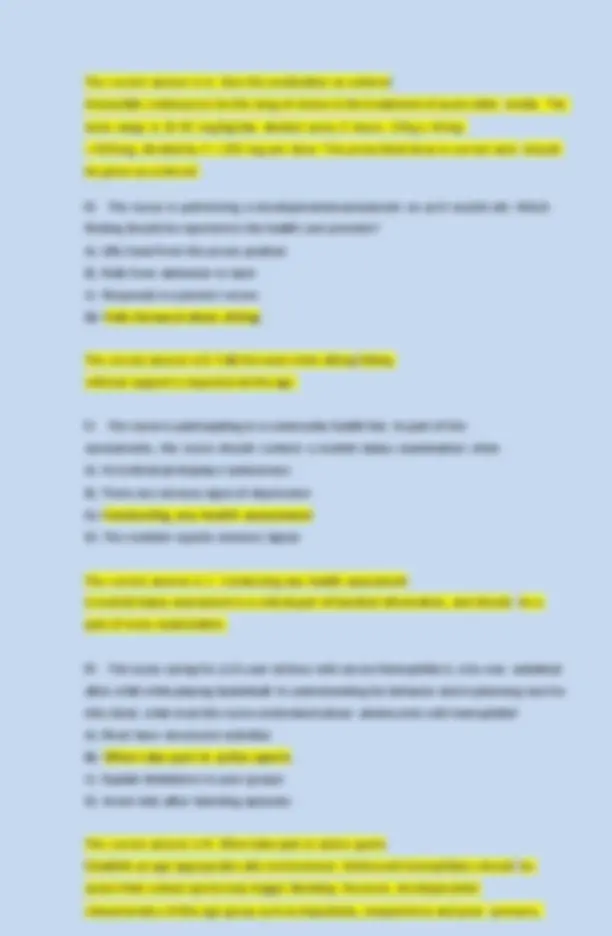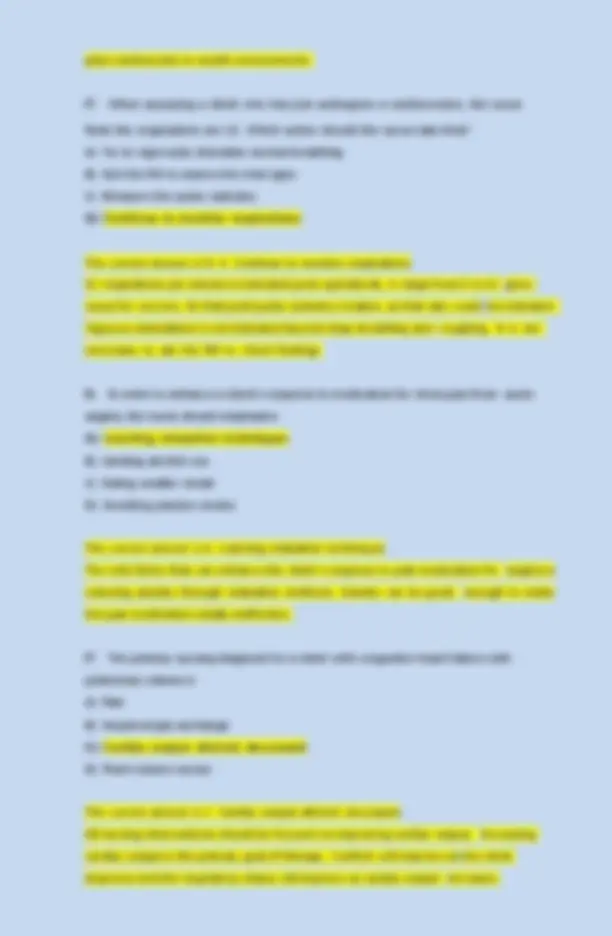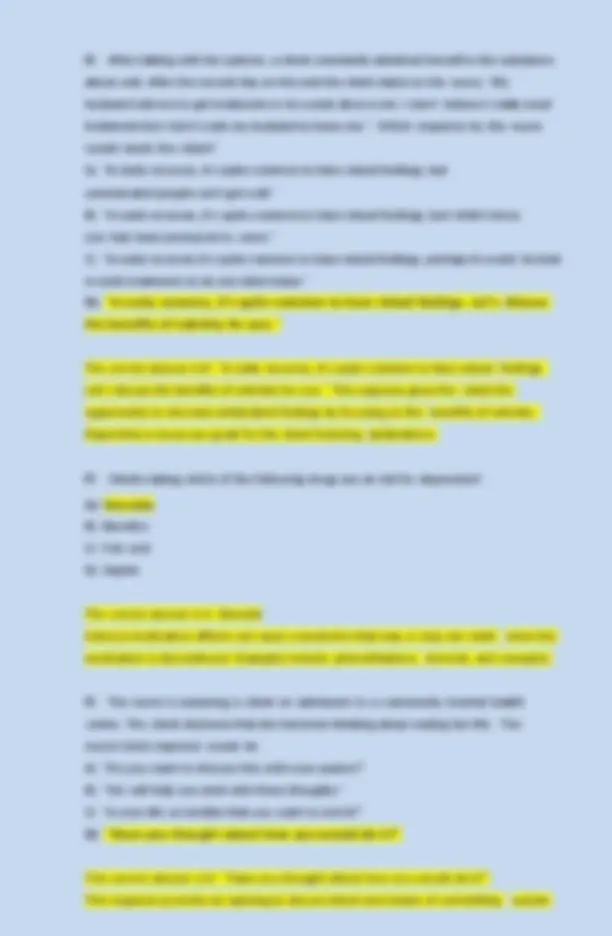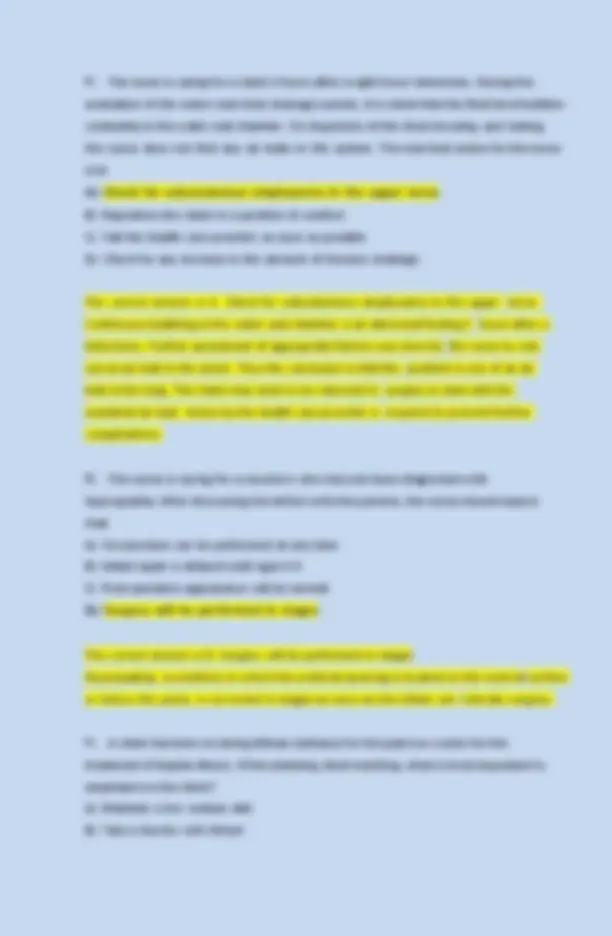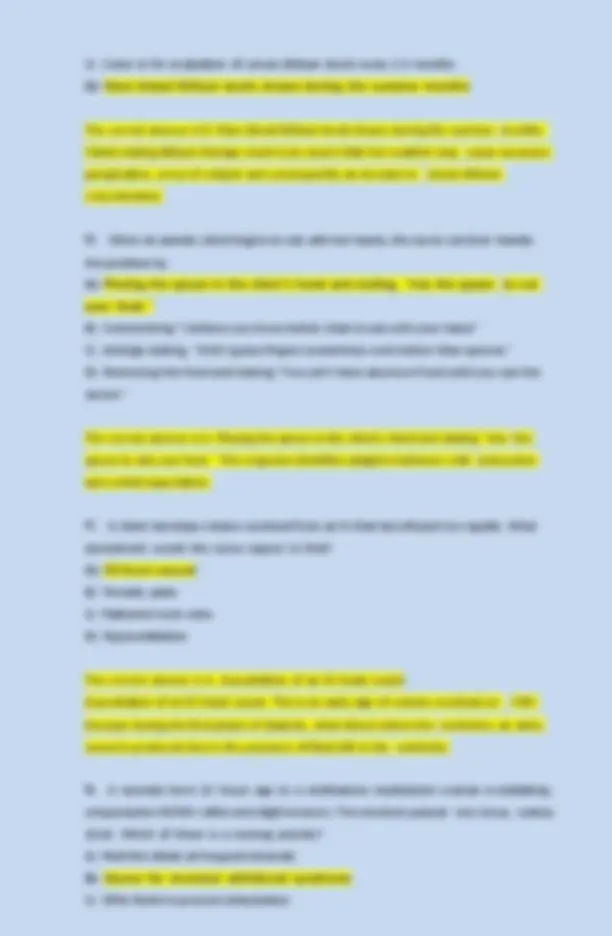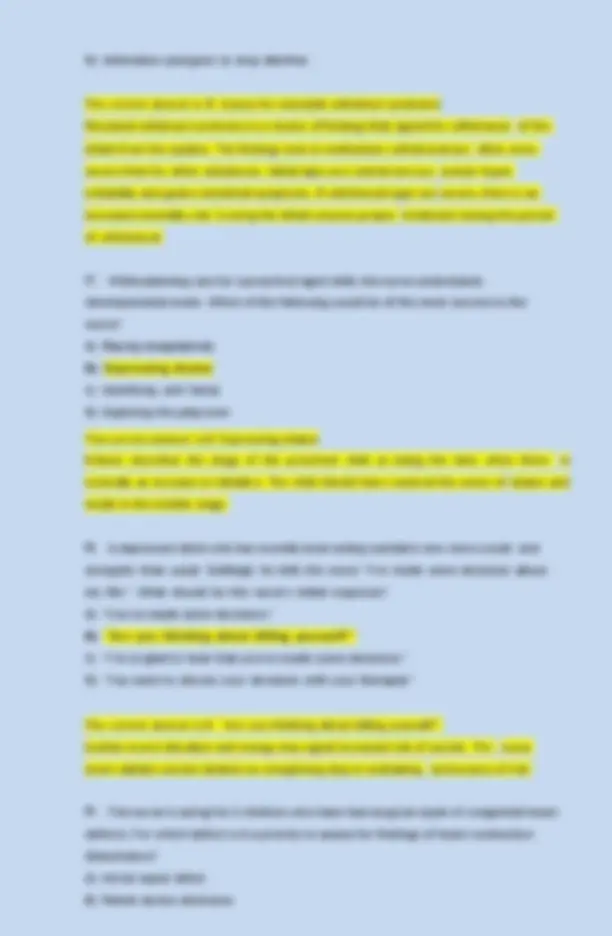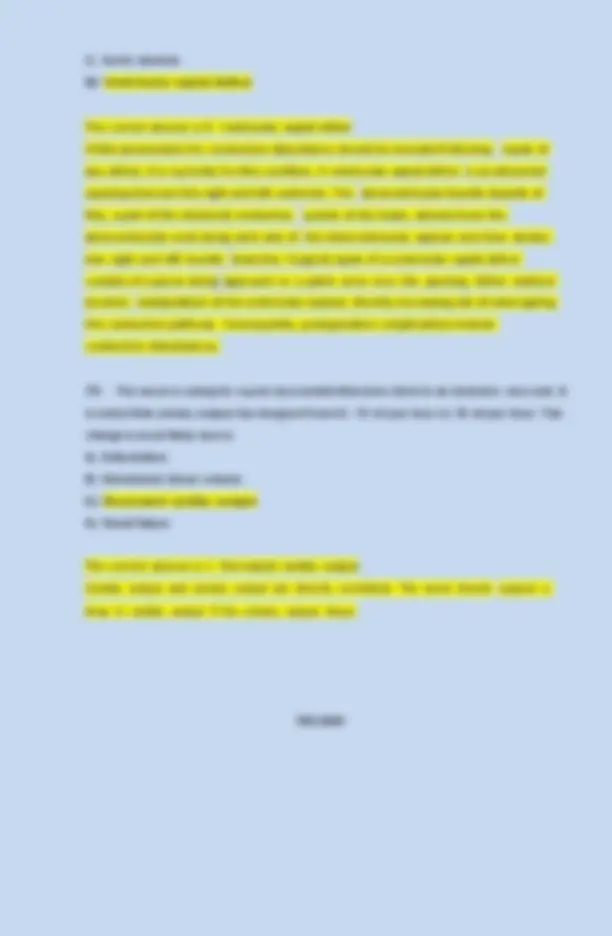Download NURSING COMPREHENSIVE EXAM QUESTIONSAND ANSWERS WITH RATIONALES UPDATE 2025-2026 and more Exams Nursing in PDF only on Docsity!
NURSING COMPREHENSIVE EXAM QUESTIONSAND
ANSWERS WITH RATIONALES UPDATE 2025- 2026
- The nurse enters the room as a 3 year-old is having a generalized seizure. Which intervention should the nurse do first? A) Clear the area of any hazards B) Place the child on the side C) Restrain the child D) Give the prescribed anticonvulsant The correct answer is B: Place the child on the side Protecting the airway is the top priority in a seizure. If a child is actively convulsing, a patent airway and oxygenation must be assured.
- A client has just returned to the medical-surgical unit following a segmental lung resection. After assessing the client, the first nursing action would be to A) Administer pain medication B) Suction excessive tracheobronchial secretions C) Assist client to turn, deep breath and cough D) Monitor oxygen saturation The correct answer is B: Suction excessive tracheobronchial secretions Suctioning the copious tracheobronchial secretions present in post-thoracic surgery clients maintains an open airway which is always the priority nursing intervention.
- A nurse from the surgical department is reassigned to the pediatric unit. The charge nurse should recognize that the child at highest risk for cardiac arrest and is the least likely to be assigned to this nurse is which child? A) Congenital cardiac defects B) An acute febrile illness C) Prolonged hypoxemia D) Severe multiple trauma The correct answer is C: Prolonged hypoxemia Most often, the cause of cardiac arrest in the pediatric population is prolonged hypoxemia. Children usually have both cardiac and respiratory arrest.
- Which of the following would be the best strategy for the nurse to use when teaching
insulin injection techniques to a newly diagnosed client with diabetes? A) Give written pre and posttests B) Ask questions during practice C) Allow another diabetic to assist D) Observe a return demonstration The correct answer is D: Observe a return demonstration Since this is a psychomotor skill, this is the best way to know if the client has learned the proper technique.
- The nurse is assessing a 2-year-old client with a possible diagnosis of congenital heart disease. Which of these is most likely to be seen with this diagnosis? A) Several otitis media episodes in the last year B) Weight and height in 10th percentile since birth C) Takes frequent rest periods while playing D) Changing food preferences and dislikes The correct answer is C: Takes frequent rest periods while playing Children with heart disease tend to have exercise intolerance. The child self- limits activity, which is consistent with manifestations of congenital heart disease in children.
- The nurse is reassigned to work at the Poison Control Center telephone hotline. In which of these cases of childhood poisoning would the nurse suggest that parents have the child drink orange juice? A) An 18 month-old who ate an undetermined amount of crystal drain cleaner B) A 14 month-old who chewed 2 leaves of a philodendron plant C) A 20 month-old who is found sitting on the bathroom floor beside an empty bottle of diazepam (Valium) D) A 30 month-old who has swallowed a mouthful of charcoal lighter fluid The correct answer is A: An 18 month-old who ate an undetermined amount of crystal drain cleaner. Drain cleaner is very alkaline. The orange juice is acidic and will help to neutralize this substance.
- A 23-year-old single client is in the 33rd week of her first pregnancy. She tells the nurse that she has everything ready for the baby and has made plans for the first weeks together at home. Which normal emotional reaction does the nurse recognize? A) Acceptance of the pregnancy B) Focus on fetal development
The correct answer is A: "Eat a balanced diet for your age." A diet for a teenager with acne should be a well-balanced diet for their age. There are no recommended additions and subtractions from the diet.
- The nurse is caring for a child who has just returned from surgery following a tonsillectomy and adenoidectomy. Which action by the nurse is appropriate? A) Offer ice cream every 2 hours B) Place the child in a supine position C) Allow the child to drink through a straw D) Observe swallowing patterns The correct answer is D: Observe swallowing patterns The nurse should observe for increased swallowing frequency to check for hemorrhage.
- The nurse is caring for a client with acute pancreatitis. After pain management, which intervention should be included in the plan of care? A) Cough and deep breathe every 2 hours B) Place the client in contact isolation C) Provide a diet high in protein D) Institute seizure precautions The correct answer is A: Cough and deep breathe every 2 hours Respiratory infections are common because of fluid in the retro peritoneum pushing up against the diaphragm causing shallow respirations. Encouraging the client to cough and deep breathe every 2 hours will diminish the occurrence of this complication.
- The nurse is caring for a client with trigeminal neuralgia (tic douloureaux). To assist the client with nutrition needs, the nurse should A) Offer small meals of high calorie soft food B) Assist the client to sit in a chair for meals C) Provide additional servings of fruits and raw vegetables D) Encourage the client to eat fish, liver and chicken The correct answer is A: Offer small meals of high calorie soft food If the client is losing weight because of poor appetite due to the pain, assist in selecting foods that are high in calories and nutrients, to provide more nourishment with less chewing. Suggest that frequent, small meals be eaten instead of three large ones. To minimize jaw movements when eating, suggest that foods be pureed.
- A client treated for depression tells the nurse at the mental health clinic that he recently purchased a handgun because he is thinking about suicide. The first nursing action should be to A) Notify the health care provider immediately B) Suggest in-patient psychiatric care C) Respect the client's confidential disclosure D) Phone the family to warn them of the risk The correct answer is A: Notify the health care provider immediately The health care provider must be contacted immediately as the client is a danger to self and others. Hospitalization is indicated.
- The initial response by the nurse to a delusional client who refuses to eat because of a belief that the food is poisoned is A) "You think that someone wants to poison you?" B) "Why do you think the food is poisoned?" C) "These feelings are a symptom of your illness." D) "You’re safe here. I won’t let anyone poison you." The correct answer is A: "You think that someone wants to poison you?" This response acknowledges perception through a reflective question which presents opportunity for discussion, clarification of meaning, and expressing doubt.
- A client has just been admitted with portal hypertension. Which nursing diagnosis would be a priority in planning care? A) Altered nutrition: less than body requirements B) Potential complication hemorrhage C) Ineffective individual coping D) Fluid volume excess The correct answer is B: Potential complication hemorrhage Esophageal varices are dilated and tortuous vessels of the esophagus that are at high risk for rupture if portal circulation pressures rise.
- The nurse in a well-child clinic examines many children on a daily basis. Which of the following toddlers requires further follow up? A) A 13 month-old unable to walk B) A 20 month-old only using 2 and 3 word sentences
increasing periods of ambulation.
- In providing care to a 14 year-old adolescent with scoliosis, which of the following will be most difficult for this client? A) Compliance with treatment regimens B) Looking different from their peers C) Lacking independence in activities D) Reliance on family for their social support The correct answer is B: Looking different from their peers Conformity to peer influences peaks at around age 14. Since many persons view any disability as deviant, the client will need help in learning how to deal with reactions of others. Treatment of scoliosis is long-term and involves bracing and/or surgery.
- The nurse is preparing to perform a physical examination on an 8 month-old who is sitting contentedly on his mother's lap. Which of the following should the nurse do first? A) Elicit reflexes B) Measure height and weight C) Auscultate heart and lungs D) Examine the ears The correct answer is C: Auscultate heart and lungs The nurse should auscultate the heart and lungs during the first quiet moment with the infant so as to be able to hear sounds clearly. Other assessments may follow in any order.
- Which of these principles should the nurse apply when performing a nutritional assessment on a 2 year-old client? A) An accurate measurement of intake is not reliable B) The food pyramid is not used in this age group C) A serving size at this age is about 2 tablespoons D) Total intake varies greatly each day The correct answer is C: A serving size at this age is about 2 tablespoons In children, a general guide to serving sizes is 1 tablespoon of solid food per year of age. Understanding this, the nurse can assess adequacy of intake.
- The nurse is assessing a client with delayed wound healing. Which of the following risk factors is most important in this situation?
A) Glucose level of 120 B) History of myocardial infarction C) Long term steroid usage D) Diet high in carbohydrates The correct answer is C: Long term steroid usage Steroid dependency tends to delay wound healing. If the client also smokes, the risk is increased.
- Which of the following nursing assessments indicate immediate discontinuance of an antipsychotic medication? A) Involuntary rhythmic stereotypic movements and tongue protrusion B) Cheek puffing, involuntary movements of extremities and trunk C) Agitation, constant state of motion D) Hyperpyrexia, severe muscle rigidity, malignant hypertension The correct answer is D: Hyperpyrexia, severe muscle rigidity, malignant hypertension, hyperpyrexia, sever muscle rigidity, and malignant hypertension are assessment signs indicative of NMS (neuroleptic malignant syndrome).
- A client with HIV infection has a secondary herpes simplex type 1 (HSV-1) infection. The nurse knows that the most likely cause of the HSV- 1 infection in this client is A) Immunosuppression B) Emotional stress C) Unprotected sexual activities D) Contact with saliva The correct answer is A: Immunosuppression The decreased immunity leads to frequent secondary infections. Herpes simplex virus type 1 is an opportunistic infection. The other options may result in HSV-1. However they are not the most likely cause in clients with HIV.
- The nurse measures the head and chest circumferences of a 20 month-old infant. After comparing the measurements, the nurse finds that they are approximately the same. What action should the nurse take? A) Notify the health care provider B) Palpate the anterior fontanel C) Feel the posterior fontanel D) Record these normal findings
C) Withholding privileges each time the voiding occurs D) Toileting the client more frequently with supervision The correct answer is D: Toileting the client more frequently with supervision With altered thought processes the most appropriate nursing approach to alter the behavior is by attending to the physical need.
- The nurse is caring for a client with a sigmoid colostomy who requests assistance in removing the flatus from a 1 piece drainable ostomy pouch. Which is the correct intervention? A) Piercing the plastic of the ostomy pouch with a pin to vent the flatus B) Opening the bottom of the pouch, allowing the flatus to be expelled C) Pulling the adhesive seal around the ostomy pouch to allow the flatus to escape D) Assisting the client to ambulate to reduce the flatus in the pouch The correct answer is B: Opening the bottom of the pouch, allowing the flatus to be expelled. The only correct way to vent the flatus from a 1 piece drainable ostomy pouch is to instruct the client to obtain privacy (the release of the flatus will cause odor), and to open the bottom of the pouch, release the flatus and dose the bottom of the pouch.
- The nurse is teaching parents of an infant about introduction of solid food to their baby. What is the first food they can add to the diet? A) Vegetables B) Cereal C) Fruit D) Meats The correct answer is B: Cereal Cereal is usually introduced first because it is well tolerated, easy to digest, and contains iron.
- When counseling parents of a child who has recently been diagnosed with hemophilia, what must the nurse know about the offspring of a normal father and a carrier mother? A) It is likely that all sons are affected B) There is a 50% probability that sons will have the disease C) Every daughter is likely to be a carrier D) There is a 25% chance a daughter will be a carrier
The correct answer is D: There is a 25% chance a daughter will be a carrier Hemophilia A is a sex-linked recessive trait seen almost exclusively in males. With a normal father and carrier mother, affected individuals are male. There is a 25% chance of having an affected male, 25% chance of having a carrier female, 25% chance of having a normal female and 25% chance of having a normal male.
- When teaching a client with chronic obstructive pulmonary disease about oxygen by cannula, the nurse should also instruct the client's family to A) Avoid smoking near the client B) Turn off oxygen during meals C) Adjust the liter flow to 10 as needed D) Remind the client to keep mouth closed The correct answer is A: Avoid smoking near the client Since oxygen supports combustion, there is a risk of fire if anyone smokes near the oxygen equipment.
- The nurse is caring for a post-op colostomy client. The client begins to cry saying, "I'll never be attractive again with this ugly red thing." What should be the first action by the nurse? A) Arrange a consultation with a sex therapist B) Suggest sexual positions that hide the colostomy C) Invite the partner to participate in colostomy care D) Determine the client's understanding of her colostomy The correct answer is D: Determine the client’s understanding of her colostomy. One of the greatest fears of colostomy clients is the fear that sexual intimacy is no longer possible. However, the specific concern of the client needs to be assessed before specific suggestions for dealing with the sexual concerns are given.
- A schizophrenic client talks animatedly but the staff are unable to understand what the client is communicating. The client is observed mumbling to herself and speaking to the radio. A desirable outcome for this client’s care will be A) Expresses feelings appropriately through verbal interactions B) Accurately interprets events and behaviors of others C) Demonstrates improved social relationships D) Engages in meaningful and understandable verbal communication The correct answer is D: Engages in meaningful and understandable verbal
predictors of infant birth weight. Specifically, teens need to increase their intake of protein, vitamins, and minerals including iron. Pregnant teens who gain between 26 and 35 pounds have the lowest incidence of low-birth- weight babies.
- A client continually repeats phrases that others have just said. The nurse recognizes this behavior as A) Autistic B) Ecopraxic C) Echolalic D) Catatonic The correct answer is C: Echolalic Echolalic - repeating words heard.
- A client is admitted for hemodialysis. Which abnormal lab value would the nurse anticipate not being improved by hemodialysis? A) Low hemoglobin B) Hypernatremia C) High serum creatinine D) Hyperkalemia The correct answer is A: Low hemoglobin Although hemodialysis improves or corrects electrolyte imbalances it has not effect on improving anemia.
- The nurse is caring for a 7 year-old child who is being discharged following a tonsillectomy. Which of the following instructions is appropriate for the nurse to teach the parents? A) Report a persistent cough to the health care provider B) The child can return to school in 4 days C) Administer chewable aspirin for pain D) The child may gargle with saline as necessary for discomfort The correct answer is A: Report a persistent cough to the health care provider. Persistent coughing should be reported to the health care provider as this may indicate bleeding.
- The nurse is caring for a 14 month-old just diagnosed with Cystic Fibrosis. The parents state this is the first child in either family with this disease, and ask about the risk to future children. What is the best response by the nurse?
A) 1in 4 chance for each child to carry that trait B) 1in 4 risk for each child to have the disease C) 1in 2 chance of avoiding the trait and disease D) 1in 2 chance that each child will have the disease The correct answer is B: 1 in 4 risk for each child to have the disease Cystic Fibrosis is an autosomal recessive transmission pattern. In this situation, both parents must be carriers of the trait for the disease since neither one of them has the disease. Therefore, for each pregnancy, there is a 25% chance of the child having the disease, 50% chance of carrying the trait and a 25% chance of having neither the trait or the disease.
- The nurse is performing an assessment on a client with pneumococcal pneumonia. Which finding would the nurse anticipate? A) Bronchial breath sounds in outer lung fields B) Decreased tactile fremitus C) Hacking, nonproductive cough D) Hyper resonance of areas of consolidation The correct answer is A: Bronchial breath sounds in outer lung fields Pneumonia causes a marked increase in interstitial and alveolar fluid. Consolidated lung tissue transmits bronchial breath sounds to outer lung fields.
- During seizure activity which observation is the priority to enhance further direction of treatment? A) Observe the sequence or types of movement B) Note the time from beginning to end C) Identify the pattern of breathing D) Determine if loss of bowel or bladder control occurs The correct answer is A: Protect the client from injury It is a priority to note, and then record, what movements are seen during a seizure because the diagnosis and subsequent treatment often rests solely on the seizure description.
- Which of the following statements describes what the nurse must know in order to provide anticipatory guidance to parents of a toddler about readiness for toilet training? A) The child learns voluntary sphincter control through repetition
D) "Full and detailed answers should be given to all questions." The correct answer is A: "When a child asks a question, give a simple answer." During discussions related to sexuality, honesty is very important. However, honesty does not mean imparting every fact of life associated with the question. When children ask 1 question, they are looking for 1 answer. When they are ready, they will ask about the other pieces.
- A 3 year-old child is treated in the emergency department after ingestion of 1ounce of a liquid narcotic. What action should the nurse do first? A) Provide the ordered humidified oxygen via mask B) Suction the mouth and the nose C) Check the mouth and radial pulse D) Start the ordered intravenous fluids The correct answer is C: Check the mouth and radial pulse The first step in treatment of a toxic exposure or ingestion is to assess the airway, breathing and circulation; then stabilize the client. The other nursing actions will follow.
- The charge nurse on the eating disorder unit instructs a new staff member to weigh each client in his or her hospital gown only. What is the rationale for this nursing intervention? A) To reduce the risk of the client feeling cold due to decreased fat and subcutaneous tissue B) To cover the bony prominence and areas where there is skin breakdown C) So the client knows what type of clothing to wear when weighed D) To reduce the tendency of the client to hide objects under his or her clothing The correct answer is D: To reduce the tendency of the client to hide objects under his or her clothing. The client may conceal weights on their body to increase weight gain.
- In teaching parents to associate prevention with the lifestyle of their child with sickle cell disease, the nurse should emphasize that a priority for their child is to A) Avoid overheating during physical activities B) Maintain normal activity with some restrictions C) Be cautious of others with viruses or temperatures D) Maintain routine immunizations
The correct answer is A: Avoid overheating Fluid loss caused by overheating and dehydration can trigger a crisis.
- The nurse understands that during the "tension building" phase of a violent relationship, when the batterer makes unreasonable demands, the battered victim may experience feelings of A) Anger B) Helplessness C) Calm D) Explosive The correct answer is B: Helplessness The battered individual internalizes appropriate anger at the batterer’s unfairness and instead feels depressed with a sense of helplessness, when the partner explodes in spite of best efforts to please the batterer.
- A parent has numerous questions regarding normal growth and development of a 10 month-old infant. Which of the following parameters is of most concern to the nurse? A) 50% increase in birth weight B) Head circumference greater than chest C) Crying when the parents leave D) Able to stand up briefly in play pen The correct answer is A: 50% increase in birth weight Birth weight should be doubled at 6 months of age, tripled at 1 year, and quadrupled by 18 months.
- The nurse has been assigned to these clients in the emergency room. Which client would the nurse go check first? A) Viral pneumonia with atelectasis B) Spontaneous pneumothorax with a respiratory rate of 38 C) Tension pneumothorax with slight tracheal deviation to the right D) Acute asthma with episodes of bronchospasm The correct answer is C: Tension pneumothorax with slight tracheal deviation to the right. Tracheal deviation indicates a significant volume of air being trapped in the chest cavity with a mediastinal shift. In tension pneumothorax the tracheal deviation is away from the affected side. The affected side is the side where the air leak is in the lung. This situation also results in sudden air hunger, agitation, hypotension, pain in the
B) Administer Valium C) Place the client in a side-lying position D) Place a tongue blade in the mouth The correct answer is C: Place the client in a side-lying position Place the client in a side-lying position to maintain an open airway, drain secretions, and prevent aspiration if vomiting occurs.
- The nurse is teaching a client who has a hip prostheses following total hip replacement. Which of the following should be included in the instructions for home care? A) Avoid climbing stairs for 3 months B) Ambulate using crutches only C) Sleep only on your back D) Do not cross legs The correct answer is D: Do not cross legs Hip flexion should not exceed 60 degrees.
- A nurse who travels with an agency is uncertain about what tasks can be performed when working in a different state. It would be best for the nurse to check which resource? A) The state nurse practice act in which the assignment is made B) With a nurse colleague who has worked in that state 2 years ago D) The Nursing Social Policy Statement within the United States C) The policies and procedures of the assigned agency in that state The correct answer is A: The state nurse practice act in which the assignment is made. The state nurse practice act is the governing document of what can be done in the assigned state.
- Parents of a 7 year-old child call the clinic nurse because their daughter was sent home from school because of a rash. The child had been seen the day before by the health care provider and diagnosed with Fifth Disease (erythema infectiosum). What is the most appropriate action by the nurse? A) Tell the parents to bring the child to the clinic for further evaluation B) Refer the school officials to printed materials about this viral illness C) Inform the teacher that the child is receiving antibiotics for the rash D) Explain that this rash is not contagious and does not require
isolation The correct answer is D: Explain that this rash is not contagious and does not require isolation. Fifth Disease is a viral illness with an uncertain period of communicability (perhaps 1 week prior to and 1 week after onset). Isolation of the child with Fifth Disease is not necessary except in cases of hospitalized children who are immunosuppressed or having aplastic crises. The parents may need written confirmation of this from the health care provider.
- What principle of HIV disease should the nurse keep in mind when planning care for a newborn who was infected in utero? A) The disease will incubate longer and progress more slowly in this infant B) The infant is very susceptible to infections C) Growth and development patterns will proceed at a normal rate D) Careful monitoring of renal function is indicated The correct answer is B: The infant is very susceptible to infections HIV infected children are susceptible to opportunistic infections due to a compromised immune system.
- While teaching a client about their medications, the client asks how long it will take before the effects of lithium take place. What is the best response of the nurse? A) Immediately B) Several days C) 2 weeks D) 1 month The correct answer is C: 2 weeks Lithium is started immediately to treat bipolar disorder because it is quite effective in controlling mania. Lithium takes approximately 2 weeks to effect change in a client’s symptoms.
- The nurse is caring for a 12 year-old with an acute illness. Which of the following indicates the nurse understands common sibling reactions to hospitalization? A) Younger siblings adapt very well B) Visitation is helpful for both C) The siblings may enjoy privacy D) Those cared for at home cope better

